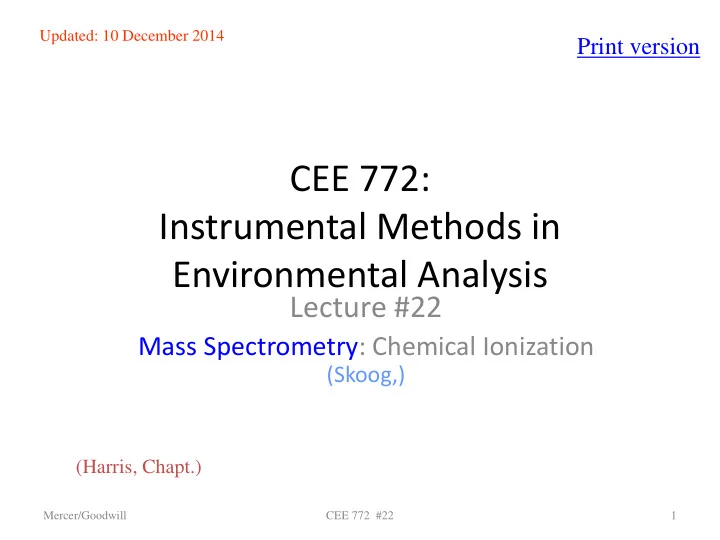

Updated: 10 December 2014 Print version CEE 772: Instrumental Methods in Environmental Analysis Lecture #22 Mass Spectrometry: Chemical Ionization (Skoog,) (Harris, Chapt.) Mercer/Goodwill CEE 772 #22 1
From: Skoog, 1985 David Reckhow CEE 772 #25 2
From: Skoog, 1985 David Reckhow CEE 772 #25 3
From: Skoog, 1985 David Reckhow CEE 772 #25 4
Chemical Ionization • Use of reagent gas at high pressures (0.2-2 torr) – Methane – Ammonia • Ionize reagent gas • These ions react with and ionize analyte – Pseudo-M ions • M-1, M, M+1 – Adduct ions • M+17, 29, 57 David Reckhow CEE 772 #25 5
CI: proton transfer • Proton transfer will occur from conjugate bases of substances of lower affinity to those higher From: Budde, 2001 David Reckhow CEE 772 #25 6
CI Spectra • Spectra of di- Methane CI isooctylphthalate Isobutane CI From: Howe et al., 1981, Mass Spectrometry, Principles and Applications David Reckhow CEE 772 #25 7
Mass Spectrometry • General References on Instrument Design – Skoog, Principles of Instrumental Analysis • 1985 (3 rd ed): parts of Chapter 18 • 1991 (4 th ed): parts of Chapter 18 • 1998 (5 th ed): parts of Chapter 20 – Howe, Williams & Bowen, Mass Spectrometry, Principles & Applications • 1981 (2 nd ed): Chapter 1 & 12 – Loconto, Trace Environmental Quantitative Analysis • 2001: pp356-370 – Budde, Analytical Mass Spectrometry • 2001, Oxford University Press, – parts of Chapter 1 & 2 David Reckhow CEE 772 #25 8
Mass Spectrometry • MS – molecules are ionized and separated based on the their mass to charge ratio (m/z) • The molecules are bombarded by electrons and the molecules release 1 or more electrons • M + e - _ > M + + 2e - David Reckhow CEE 772 #25 9
MS Schematic Figure 18-1, Skoog David Reckhow CEE 772 #25 10
MS Inlet System • Introduce the sample to the MS • 3 types – batch inlet – direct probe inlet – chromatographic inlet David Reckhow CEE 772 #25 11
MS - Batch Inlet • Most common inlet system • Gas or liquid sample is volatized externally, then leaks into ionization area • A vacuum pressure of 10 -4 to 10 -5 torr is applied to the inlet system David Reckhow CEE 772 #25 12
MS – Direct Probe Inlet • Used for solids and nonvolatile liquids • A sample holder (probe) is used to insert the sample into the ionization region • A vacuum lock system is used to minimize the volume of air that must pumped from the system after the probe is inserted in the ionization area • The probe’s tip is surrounded a heating coil to heat or cool the sample David Reckhow CEE 772 #25 13
MS - Chromatographic Inlet System • Capillary column output can be fed directly into the ionization region because its flow rate is very small • Packed column output must flow through a jet separator to remove most of the carrier gas David Reckhow CEE 772 #25 14
Sample Introduction • General types of devices David Reckhow CEE 772 #25 15
Sample Introduction • Sample probe David Reckhow CEE 772 #25 16
Interfaces • Jet Separator David Reckhow CEE 772 #25 17
Ion Source • Electron Impact David Reckhow CEE 772 #25 18
Ion Source • Electron Impact From: McLafferty, 1980 David Reckhow CEE 772 #25 19
Interface & Ion Source • Electrospray Ionization David Reckhow CEE 772 #25 20
Ion Source • Electrical Impact Ionization (EI) – molecules are bombarded with electrons with KE of 70 eV that cause them to be ionized – EI causes great amount of fragmentation in large molecules causing the mass spectra to be difficult to interpret • Chemical Ionization (CI) – the ion source is filled with a reagent gas, usually methane, at a pressure = 100 Pa. CH 4 react with electrons to form reactive products + such as CH 5 + reacts with the molecule to form CH 4 and MH + – CH 5 – Softer method – less fragmentation occurs David Reckhow CEE 772 #25 21
• To next lecture Mercer/Goodwill CEE 772 #22 22
Recommend
More recommend